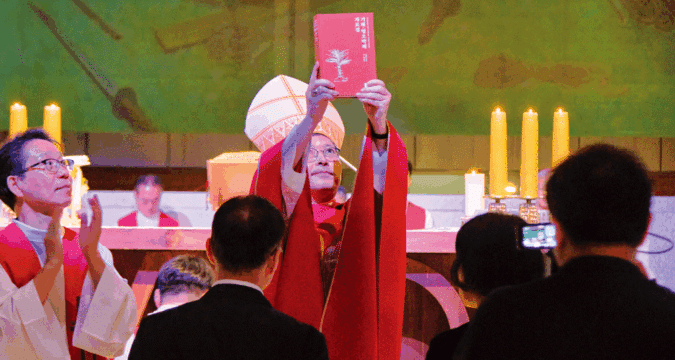
SEOUL (SE): More than 1,000 faithful gathered at the Seosomun Shrine History Museum to mark the centenary of the beatification of the 79 Korean martyrs of the Gihae [1839] and Byeong-o [1846] persecutions on July 5.
Archbishop Peter Soon-taick Chung of Seoul celebrated the Mass at the historic site where 41 of the martyrs gave their lives for the faith, the Committee for Communication, Archdiocese of Seoul announced in a press release on July 7.
The centennial was very important for the Korean Catholic Church. In 1846, after the Gihae and Byeong-o persecutions, Bishop Jean-Joseph-Jean-Baptiste Ferréol, the vicar apostolic of Korea, created an expanded Journal of the Gihae Year. This was translated into Latin by Thomas Choi Yang-eop, who was a deacon at the time and later became a priest.
The document was sent to the Holy See and set the stage for a process that, nearly 80 years later, led to Pope Pius XI declaring 79 Korean Catholics as Blessed at St. Peter’s Basilica on 5 July 1925, in recognition of their courage during persecution.
During the liturgy, the Martyrs Elevation Committee of the Archdiocese of Seoul formally presented the new compilation, The Documentation of the Gihae and Byeong-o Persecutions, to honour the memory of the martyrs and to support continued research into Korean Church history.
The centennial was very important for the Korean Catholic Church. In 1846, after the Gihae and Byeong-o persecutions, Bishop Jean-Joseph-Jean-Baptiste Ferréol, the vicar apostolic of Korea, created an expanded Journal of the Gihae Year
This work, which drew from royal chronicles, judicial records, and state archives of the Joseon Dynasty, featured the original classical Chinese texts alongside Korean translations, making these important testimonies accessible both to scholars and to the wider Catholic community.
In his homily, Archbishop Chung invited those gathered to reflect on the legacy of the martyrs. Quoting St. Paul’s letter to the Romans, he said, “The lives of the martyrs were precisely such a journey. ‘We even boast of our afflictions, knowing that affliction produces endurance, and endurance, proven character, and proven character, hope.’ Even in the trials of persecution, they never abandoned their faith in the Lord. Their endurance deepened their faith, which ultimately bore fruit as true hope that overcame even death.”
The archbishop also emphasised, “This is the first time that historical facts from official records—interrogations, reports, and directives from institutions like the Royal Secretariat and the State Council—have been carefully extracted, translated, and compiled, rather than relying solely on testimonies. Even though these were records written by the persecutors, the courageous faith and deep conscience of the martyrs stand out all the more clearly within them.”
Following the Mass, a special exhibition entitled Anima Mundi–Souls of the World was inaugurated at the Seosomun Shrine History Museum. Running through September 14, the exhibition commemorates the centenary of the 1925 Vatican Missionary Exhibition, which differed from earlier Western-centred fairs by highlighting the dignity of diverse cultures and promoting understanding among peoples.
The exhibition showcased a vivid reconstruction of the original Joseon Pavilion, featuring over 270 artifacts collected from 16 Korean museums and monasteries, as well as items borrowed from the Vatican’s Ethnological Museum. This provided visitors with a unique opportunity to explore how Korea presented its cultural and spiritual heritage to the world a century ago.
Additionally, the exhibition encouraged reflection on the importance of respect, dialogue, and peaceful coexistence among nations, highlighting values that remain essential today, just as they were for Korea’s early witnesses of faith.



